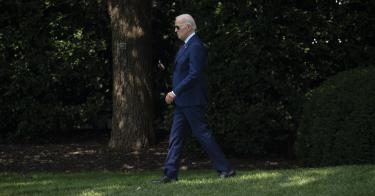The investment community’s patience with the Biden administration’s fiscal irresponsibility is wearing thin. After a year of falling Treasury prices, the U.S. debt has been downgraded, indicating that the administration is leading the nation to an eventual default.
That’s bad news for America, especially since the government has chosen to play politics instead of addressing the problem.
The concerns are justified. In less than three years, President Biden has achieved 40-year-high inflation, multitrillion-dollar deficits, and a record-breaking debt whose interest payments are an annualized $1 trillion.
This led Fitch Ratings Inc., the nation’s third-largest nationally recognized statistical ratings organization, to downgrade U.S. Treasurys.
To be clear, this is not an indication of imminent default; Fitch still considers U.S. debt to be investment-grade sovereign debt with a very high likelihood of repayment. But once you factor inflation into the mix, you find out the U.S. has been covertly defaulting on its debt under Mr. Biden.
>>> 4 Images Reveal How Congress Is Committing an $11 Billion Fraud on American Public
Investors have seen the value of their U.S. Treasurys plummet because of inflation. Lending the U.S. government money in the last 2½ years has been a losing proposition because U.S. Treasurys have gained less from interest than they’ve lost from inflation.
In other words, the government is repaying you with dollars that can buy less than you originally lent to the U.S. Treasury.
Rampant inflation is one reason why a downgrade of U.S. Treasurys was well deserved. The drunken-sailor-style spending out of D.C. is another. The median nation with AAA-rated securities has a debt-to-GDP (gross domestic product) ratio of just 39%.
Fitch estimates the U.S. public debt ratio will be 118% by 2025. That’s unsustainable and a path to default.
But Fitch is not the first major credit ratings organization to downgrade U.S. debt. Standard & Poor’s did so around the time of the 2011 debt ceiling clash. Just two weeks later, the federal government opened an investigation of S&P’s role in the 2008 mortgage crisis.
This quickly led to the ouster of S&P’s CEO—just 18 days from downgrade to unemployment. Even typically left-leaning media outlets connected the dots and questioned the timing of the Democratic-run Securities and Exchange Commission. The U.S. has become a nation of laws selectively enforced.
Egan-Jones, a less prominent credit ratings provider, was the first to downgrade U.S. Treasurys in 2011, and it lowered its rating on U.S. debt twice more before the end of 2012. Perhaps as punishment for being first and more aggressive than S&P, the SEC revoked Egan-Jones’ authorization to rate sovereign debt.
Clearly, if you dare question the leviathan, it will snap back with its crocodilian jaws. To this day, Egan-Jones is banned from rating U.S. debt.
It remains to be seen if the Biden administration will also punish Fitch, but for now, the White House strongly disagrees with the downgrade, with Treasury Secretary Janet Yellen saying that Fitch used outdated numbers.
Ms. Yellen doesn’t seem to realize that the most recent figures actually provide an even worse outlook than Fitch cited: The Treasury is borrowing money at an appalling rate of about $1.6 trillion a year. Ms. Yellen somehow failed to mention this complete fiscal mismanagement in her assessment of Fitch’s decision.
Likewise, Mr. Biden failed to take any responsibility, instead blaming former President Donald Trump—who hasn’t been president for 2½ years. While the government did spend too much money under Mr. Trump, Mr. Biden has doubled down on that error and is pushing the country toward financial catastrophe.
Contrary to Mr. Biden’s claims about cutting the deficit, he has been increasing it: The deficit is up 170% on last year alone. Government spending is at an all-time high, both in nominal and inflation-adjusted terms. Financing costs on the debt are exploding as the economy slows down, which will reduce revenue and exacerbate the deficit.
The question is not why did Fitch downgrade U.S. debt, but what took so long.
Sadly, instead of addressing the massive problems in federal finance today, the Biden administration is continuing the pattern of playing politics with the nation’s creditworthiness while casting blame and throwing political stones from inside their glass house of gross mismanagement.
This piece originally appeared in The Washington Times




